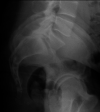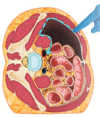Single-Position Anterior Column Lateral Lumbar Interbody Fusion
- PMID: 35387885
- PMCID: PMC9983566
- DOI: 10.14444/8232
Single-Position Anterior Column Lateral Lumbar Interbody Fusion
Abstract
Lateral lumbar fusion is a commonly used spinal fusion technique that allows for indirect neural decompression while correcting sagittal malalignment. The lateral position has evolved to include placement of percutaneous pedicle screw fixation, anterior longitudinal ligament release, and approach the L5-S1 segment. This review article focuses on the anatomy and technique of the single-position anterior column spinal fusion and highlights the recent trends, outcomes, and future directions for the approach.
Keywords: LLIF; lumbar fusion; spine surgery.
This manuscript is generously published free of charge by ISASS, the International Society for the Advancement of Spine Surgery. Copyright © 2022 ISASS. To see more or order reprints or permissions, see http://ijssurgery.com.
Conflict of interest statement
Declaration of Conflicting Interests: The authors report no conflicts of interest related to this work.
Figures







References
LinkOut - more resources
Full Text Sources
